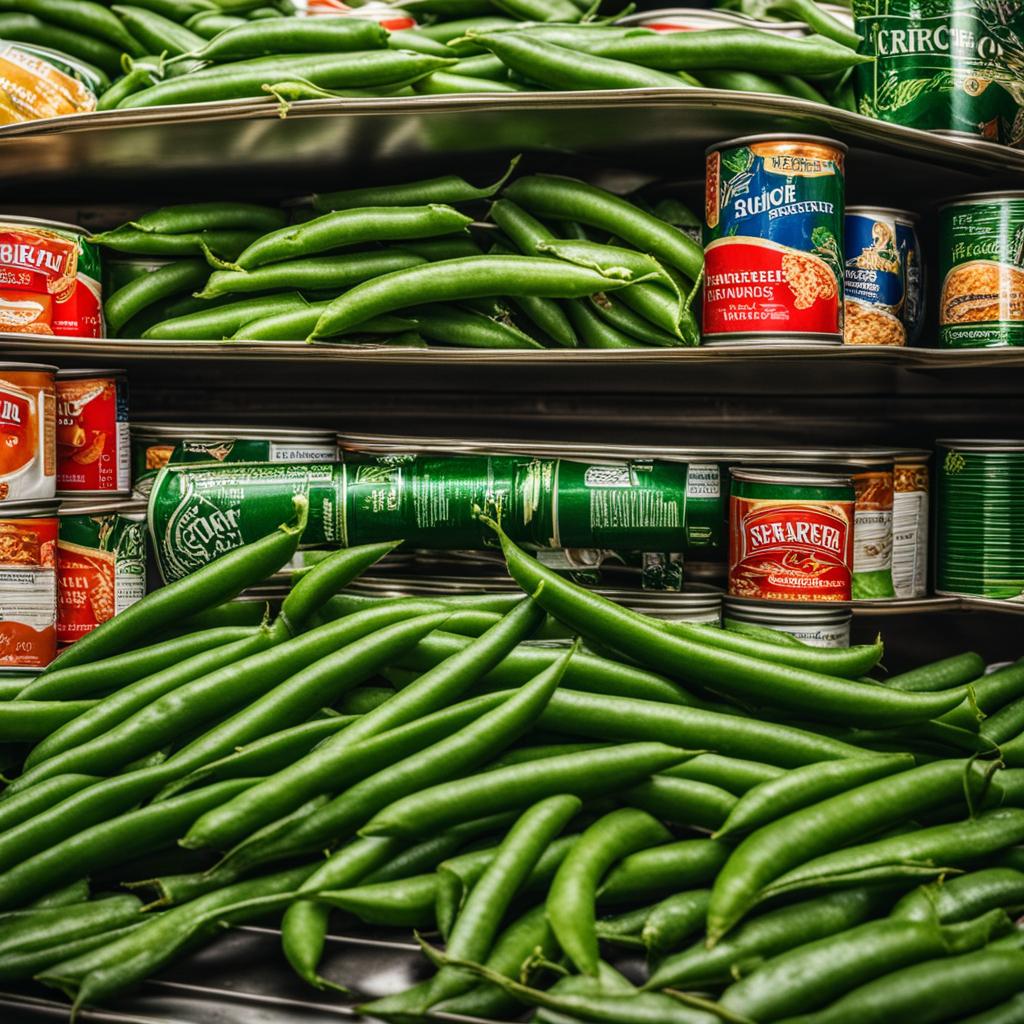Greetings! In today’s article, I will guide you on how to tell if canned foods are bad. It’s essential to be able to identify signs of spoilage in canned foods to ensure the safety and quality of your meals. By recognizing certain indicators, you can identify spoiled canned foods and avoid consuming them.
Key Takeaways:
- Being able to identify signs of spoilage in canned foods is crucial for food safety.
- Pay attention to indicators such as odor, color, texture, and taste.
- Proper food safety and storage practices are essential for maintaining the quality of canned foods.
- Regularly check your pantry for spoiled canned foods to ensure freshness.
- If you find spoiled canned foods, handle them appropriately to prevent contamination.
Understanding the Risks of Spoiled Canned Foods
When it comes to pantry staples, it’s important to prioritize freshness and be aware of the risks of consuming spoiled canned foods. While canned foods are known for their convenience and long shelf life, it’s crucial to understand that they can still spoil over time. Spoiled canned foods can pose health risks due to the growth of bacteria and the production of toxins, making it essential to identify signs of spoilage and avoid consuming them.
Proper storage of canned foods plays a significant role in preventing spoilage. Storing canned goods in a cool and dry pantry, away from direct sunlight and extreme temperatures, can help maintain their freshness. Avoid purchasing dented or damaged cans, as they may be more prone to spoilage. Additionally, always check the expiration dates on canned goods and prioritize using older cans before newer ones to ensure optimal freshness.
“Spoiled canned foods can pose health risks due to the growth of bacteria and the production of toxins.”
By understanding the risks of consuming spoiled canned foods and implementing proper storage practices, you can safeguard your health and enjoy the convenience of pantry staples without compromising on safety. Stay vigilant and trust your senses when it comes to identifying signs of spoilage in canned foods to ensure that every meal you prepare is fresh, delicious, and safe to consume.
Table: Common Signs of Spoiled Canned Foods
| Signs | Description |
|---|---|
| Unpleasant odor | A foul or rancid smell when you open the can |
| Unusual color | Mold, dark spots, or a change in color |
| Altered texture | Mushiness, sliminess, or an unusual consistency |
| Off taste | Bitter, sour, metallic, or abnormal flavor |
Signs of Spoiled Canned Foods: Odor
One of the most apparent signs of spoiled canned foods is a foul or unpleasant odor. When you open a can and notice a strong, rancid, or off-putting smell, it’s a clear indication that the food inside has gone bad. Trust your sense of smell, as it can often detect spoilage before other visible signs appear.
It’s important to note that not all canned foods have a strong odor when spoiled. Some may have a more subtle change in smell, while others can be overpowering. Regardless, any abnormal or unpleasant odor should be taken seriously, as it can be a sign of bacterial growth or spoilage.
To ensure the safety and quality of your meals, discard any canned food with an unusual odor. This precautionary step minimizes the risk of consuming spoiled food, which can lead to foodborne illnesses and discomfort.
Examples of Odor in Spoiled Canned Foods
| Normal Odor | Spoiled Odor |
|---|---|
| Neutral or mild scent | Strong and rancid smell |
| No distinct or unpleasant odor | Foul or putrid odor |
| Familiar aroma of the food inside | Unusual or off-putting smell |
Table: Examples of Odor in Spoiled Canned Foods
Signs of Spoiled Canned Foods: Color
When evaluating the freshness of canned foods, one important indicator to consider is the color of the product. A change in color can often be a clear sign that a canned food item has spoiled and should not be consumed. Paying attention to any unusual or unnatural discoloration can help protect you and your family from potential health risks.
Normal canned foods should retain their original color, which may vary depending on the type of food. For example, canned fruits should maintain their vibrant hues, while canned vegetables may have a slightly muted color. However, if you notice any mold, dark spots, or a significant change in color, it is likely that the food inside the can has spoiled.
It’s important to note that slight variations in color, such as a slightly darker or lighter shade than expected, may not necessarily indicate spoilage. However, when in doubt, it’s best to err on the side of caution and discard any canned food that appears visually compromised.
| Color Indicator | Possible Spoilage |
|---|---|
| Unusual discoloration | Sign of spoilage |
| Mold or dark spots | Sign of spoilage |
| Significant change in color | Sign of spoilage |
| Slight variation in color | Not necessarily spoilage, use discretion |
Visual cues can be highly informative when it comes to assessing the freshness of canned foods. By closely examining the color of canned food items, you can make informed decisions about their safety and quality. Remember to always prioritize your health and well-being by discarding any canned foods that show signs of spoilage.
Signs of Spoiled Canned Foods: Texture
When it comes to determining the freshness of canned foods, texture is a key indicator. Changes in texture can be a clear sign that the food has spoiled and should not be consumed. As I mentioned earlier, canned foods should have a firm and consistent texture. If you notice any abnormalities such as mushiness, sliminess, or an unusual consistency, it’s best to err on the side of caution and discard the food.
Texture changes can occur due to various factors, including bacterial growth, enzymatic activity, or improper canning processes. These changes can not only compromise the taste and quality of the food but also pose health risks if consumed.
To help you better understand the impact of texture changes in spoiled canned foods, I have prepared a table that outlines the different textural variations you may come across and what they signify:
| Texture Variation | Significance |
|---|---|
| Mushy or Soft | Indicates breakdown of the food’s structure, likely due to bacterial or enzymatic activity. |
| Slimy or Slippery | Suggests the presence of bacteria or mold growth, which can lead to foodborne illnesses. |
| Grainy or Gritty | May indicate crystallization or the presence of spoilage organisms, rendering the food unsafe to eat. |
| Foamy or Bubbly | Signifies microbial activity, possibly caused by fermentation or contamination during the canning process. |
Remember, it’s always better to be safe than sorry when it comes to consuming canned foods with texture variations. If you encounter any of these textural changes, it’s recommended that you dispose of the food and avoid consuming it.
Signs of Spoiled Canned Foods: Taste
When it comes to assessing the quality of canned foods, taste plays a crucial role in determining if a product has spoiled. As a consumer, it’s essential to trust your taste buds and be aware of any unpleasant flavors or off-putting tastes that may indicate spoilage.
Upon opening a can, if you detect a bitter, sour, metallic, or otherwise abnormal taste, it’s a clear sign that the food inside has gone bad. This can be caused by bacterial growth, the accumulation of toxins, or other chemical changes that occur over time.
To ensure food safety, it is strongly recommended to discard any canned food with an unappetizing taste. Consuming spoiled canned foods can lead to foodborne illnesses and other health risks. Prioritizing your well-being by avoiding potentially contaminated items is of utmost importance.
Table: Common Abnormal Tastes in Spoiled Canned Foods
| Taste | Spoilage Indicator |
|---|---|
| Bitter | Possible presence of toxins or bacterial growth |
| Sour | Fermentation or microbial activity |
| Metallic | Chemical reactions, spoilage due to packaging or prolonged storage |
| Off or abnormal flavor | Unidentified changes in the food composition, spoilage |
“Trust your taste buds and discard any canned food with an unappetizing taste.”
Remember, taste is one of the most reliable indicators of spoilage in canned foods. Trust your senses, exercise caution, and prioritize your safety by avoiding the consumption of potentially contaminated items. By doing so, you can ensure the quality and enjoyment of your meals.
Culinary Tips for Evaluating Canned Foods
As a chef or home cook, I understand the importance of ensuring the freshness and quality of ingredients, including canned foods. Incorporating canned goods into our culinary creations can provide convenience and versatility in the kitchen. However, it’s crucial to have the knowledge and skills to evaluate canned foods to ensure their safety and optimal flavor.
When it comes to cooking with canned foods, it’s essential to consider proper cooking techniques and storage methods. While canned foods have a longer shelf life, it’s still important to use them within a reasonable timeframe to maintain their freshness and nutritional value. Incorporate older canned goods into recipes where their flavors can be enhanced, and prioritize using newer ones for dishes that require the best quality ingredients.
Understanding the nutritional content of canned foods is also vital for creating balanced and nutritious meals. Many canned goods retain a high amount of their original nutrients, making them a valuable addition to a well-rounded diet. Take the time to read the nutrition labels on canned products to determine their nutritional benefits and incorporate them into your recipes accordingly.
| Cooking Tips | Storage Tips |
|---|---|
| • Drain and rinse canned vegetables to reduce sodium content. | • Store canned foods in a cool, dry place away from direct sunlight. |
| • Use canned fruits in desserts or as toppings for added sweetness. | • Check expiration dates regularly and prioritize using older cans first. |
| • Incorporate canned beans into soups, stews, and salads for added protein. | • Transfer any leftovers from opened cans into airtight containers for refrigeration. |
By following these culinary tips, you can confidently evaluate and utilize canned foods to their fullest potential. Experiment with different recipes and explore the versatility that canned goods can offer in your culinary creations. Remember to prioritize freshness, nutritional value, and safe food preparation practices to ensure the excellence of your dishes.

Common Physical Indicators of Spoiled Canned Foods
When it comes to canned foods, it’s essential to be aware of various physical signs that can indicate spoilage. By paying attention to these signs, you can avoid consuming potentially harmful food and ensure the safety of your meals.
Bulging or Swollen Cans
One of the most significant physical indicators of spoilage is a bulging or swollen can. If you notice that a canned food item has an unusually inflated appearance, it’s a strong indication that harmful bacteria may be growing inside the can. The pressure caused by bacterial activity can lead to the expansion of the can, making it important to avoid consuming such products.
Leakage
An obvious sign of spoiled canned food is leakage. If you notice any liquid seeping out from the can, it’s a clear indication of spoilage and potential contamination. Leakage can occur due to the breakdown of the can or the growth of bacteria, both of which can compromise the safety and quality of the food inside.
Rust or Corrosion
Another physical sign of spoilage to watch out for is rust or corrosion on the can’s surface. Canned foods with rusted or corroded cans can be a breeding ground for bacteria. The presence of rust can weaken the can’s integrity and lead to leaks or further contamination, making it essential to discard any cans showing signs of rust.
Dents
Dents on the surface of a canned food can also be an indicator of spoilage. When a can is dented, it can create openings or weak spots in the seal, allowing bacteria to enter and spoil the food. If you come across any dented cans, it’s best to err on the side of caution and avoid consuming their contents.
| Physical Indicators of Spoiled Canned Foods | Significance |
|---|---|
| Bulging or Swollen Cans | Indicates the growth of harmful bacteria inside the can. |
| Leakage | Suggests spoilage and potential contamination. |
| Rust or Corrosion | Can weaken the can’s integrity and lead to leaks or further contamination. |
| Dents | Creates openings or weak spots in the seal, allowing bacteria to enter and spoil the food. |
The Importance of Food Safety and Storage
As a responsible consumer, ensuring food safety and proper storage of perishable and non-perishable items should be a top priority. Whether you’re a regular grocery shopper or someone who relies on pantry staples, understanding the best practices for food safety can prevent spoilage and maintain the quality of your meals. By following a few essential food tips and adopting convenient storage methods, you can prolong shelf life and minimize the risk of consuming spoiled canned foods.
When it comes to grocery shopping, being mindful of expiration dates and selecting items with longer shelf lives can make a significant difference in maintaining food quality. Check the “best by” or “use by” dates on canned food labels to ensure you’re purchasing products with sufficient remaining shelf life. Additionally, examining the packaging for any signs of damage or bulging cans can help you avoid potentially contaminated items. It’s crucial to prioritize the purchase of non-perishable foods that are properly sealed and undamaged.
“Proper storage techniques play a fundamental role in preserving the freshness and taste of canned foods.”
Table: Best Practices for Food Safety and Storage
| Food Safety Tips | Storage Methods |
|---|---|
| 1. Check expiration dates before purchasing canned foods. | 1. Store canned foods in a cool, dry place, away from direct sunlight. |
| 2. Inspect cans for any signs of damage, such as bulging or leakage. | 2. Keep cans upright to prevent moisture from entering and compromising the food. |
| 3. Follow proper rotation techniques to use older canned goods first. | 3. Avoid storing canned foods near heat sources or in overly humid environments. |
| 4. Store canned foods away from strong-smelling items to prevent flavor absorption. | 4. Seal opened cans tightly with plastic wrap or transfer contents to an airtight container. |
Proper storage techniques play a fundamental role in preserving the freshness and taste of canned foods. Storing them in a cool, dry place, away from direct sunlight, helps maintain their quality. Keeping cans upright and away from moisture sources prevents the risk of bacterial growth. It’s also important to follow proper rotation techniques, using older canned goods first to ensure they’re consumed before reaching their expiration dates.
By adhering to these food safety practices and employing effective storage methods, you can enjoy the convenience and extended shelf life of canned foods while minimizing the risk of consuming spoiled items. Remember that maintaining food safety is not only essential for your well-being but also for the overall enjoyment of your meals.
Ensuring Food Quality in the Culinary Arts
In the culinary arts, ingredient selection is a crucial aspect of maintaining high food quality. As a chef, I understand the importance of choosing the freshest and highest-quality ingredients for my dishes. Whether it’s selecting the ripest fruits and vegetables, the finest cuts of meat, or the most flavorful herbs and spices, ingredient selection sets the foundation for a truly exceptional culinary experience.
Having extensive food knowledge is another key factor in ensuring food quality. Understanding the flavor profiles, textures, and cooking techniques associated with different ingredients allows me to create harmonious and well-balanced dishes. With a deep understanding of ingredients, I can make informed decisions about their pairing and preparation methods, resulting in exquisite flavors and textures that delight the palate.
Food preparation techniques also play a vital role in maintaining food quality. From proper handling and storage to precise cutting and cooking methods, every aspect of food preparation contributes to the overall taste, texture, and presentation of a dish. As a chef, I take great care in ensuring that each ingredient is prepared with precision and attention to detail, resulting in dishes that are not only visually appealing but also bursting with flavor.
The Importance of Ingredient Selection
When it comes to creating exceptional culinary masterpieces, ingredient selection is paramount. Each ingredient chosen contributes to the overall taste, texture, and visual appeal of a dish. To ensure the highest quality, I prioritize sourcing ingredients from reputable suppliers who prioritize freshness and sustainability. By using the best ingredients available, I can elevate the dining experience and create dishes that leave a lasting impression on my guests.
| Ingredient | Source | Quality |
|---|---|---|
| Organic vegetables | Local farmers’ market | Fresh, pesticide-free |
| Grass-fed beef | Trusted butcher | Tender, flavorful |
| Artisanal cheeses | Specialty cheese shop | Handcrafted, unique flavors |
| Exotic spices | Authentic international markets | Premium quality, authentic taste |
Cultivating Food Knowledge
Continuing to expand my food knowledge is essential in the culinary arts. I dedicate time to experimenting with new ingredients, cuisines, and cooking techniques to stay updated with the latest culinary trends and innovations. This constant pursuit of knowledge allows me to bring new and exciting flavors to the table, keeping my guests engaged and satisfied with each culinary creation.
- Attending culinary workshops and seminars
- Exploring diverse cookbooks and recipes
- Collaborating with fellow chefs and colleagues
“In the culinary arts, ingredient selection, food knowledge, and precise food preparation techniques are the cornerstones of creating exceptional dishes.”
The Importance of Regularly Checking Canned Foods
As someone who frequently relies on pantry staples for convenience and non-perishable options, it’s crucial to prioritize regular checks on your canned foods. By incorporating this simple step into your routine, you can ensure the safety and quality of your meals while minimizing the risk of consuming spoiled goods.
Regular inventory management should be a part of your grocery shopping habits, allowing you to assess the freshness of your canned foods and prioritize the use of older items. By keeping track of expiration dates, you can make informed decisions about what to use first and replenish your pantry with fresh, non-perishable options during your shopping trips.
By regularly checking your canned foods, you can prevent the consumption of spoiled goods and minimize the chances of experiencing foodborne illnesses. Maintaining food safety in your kitchen starts with proper storage and safe handling practices, and regular checks on your canned foods are an essential component of that process.
Table: Benefits of Regularly Checking Canned Foods
| Benefits | Description |
|---|---|
| Ensures food safety | Regular checks help identify and discard spoiled canned foods, minimizing the risk of consuming contaminated goods. |
| Prevents foodborne illnesses | By being vigilant in checking for spoilage signs, you can avoid consuming canned foods that may cause illness. |
| Maximizes pantry freshness | Regular inventory management allows you to prioritize the use of older canned goods, ensuring you always have fresh options available. |
| Reduces food waste | By discarding spoiled canned foods, you can minimize food waste and make more sustainable choices in your kitchen. |
By implementing regular checks on your canned foods, you can enjoy the convenience and reliability of pantry staples while prioritizing food safety and maintaining the quality of your meals.
Detoxifying and Disposing of Spoiled Canned Foods
When you come across a canned food item that is clearly spoiled and unsafe to consume, it is crucial to handle the situation appropriately to prevent the spread of contamination. Proper detoxification and disposal methods can help eliminate harmful bacteria and ensure food safety.
To detoxify contaminated canned foods, the most effective method is to boil the cans. Fill a large pot with water and bring it to a rolling boil. Submerge the spoiled cans in the boiling water for at least 10 minutes. This process will help kill any bacteria or toxins present in the food.
After detoxification, it is important to dispose of the spoiled canned foods properly. It is recommended to wrap the cans securely in a plastic bag to prevent any leakage or contact with other items. Then, dispose of the bagged cans in a designated landfill or follow local waste disposal guidelines. Avoid placing them in regular household trash bins to minimize the risk of contamination.
Additionally, it is crucial to thoroughly clean and disinfect any surfaces or utensils that came into contact with the spoiled canned foods. Use hot, soapy water to wash countertops, cutting boards, and utensils, and then follow up with a sanitizer or a bleach solution to ensure proper disinfection. Remember to wear protective gloves during the cleaning process to minimize any direct contact with the contaminated surfaces.
Detailed Steps for Detoxifying and Disposing of Spoiled Canned Foods:
- Boil a large pot of water.
- Submerge the spoiled cans in the boiling water for at least 10 minutes.
- Remove the cans from the boiling water using tongs or a heat-resistant utensil.
- Allow the cans to cool completely.
- Securely wrap the cooled cans in a plastic bag to prevent leakage.
- Dispose of the bagged cans in a designated landfill or follow local waste disposal guidelines.
- Wash and sanitize any surfaces or utensils that came into contact with the spoiled canned foods.
- Use hot, soapy water to clean, and then follow up with a sanitizer or a bleach solution for disinfection.
- Wear protective gloves during the cleaning process to minimize direct contact with contaminated surfaces.
Cleaning and Safety Measures in Spoiled Food Situations
When dealing with spoiled food situations, it is crucial to prioritize cleaning and safety measures to prevent the spread of harmful bacteria. Contaminated food can pose serious health risks, so it is essential to take appropriate steps to ensure food safety and minimize the risk of illness.
Cleaning up after a food contamination incident requires thoroughness and attention to detail. Here are some essential cleaning and safety measures to follow:
1. Properly handle and dispose of contaminated items
Start by carefully removing any spoiled or contaminated food from the area. Wear disposable gloves to prevent direct contact with the contaminated items and double bag them in sealed plastic bags. Place the bags in a secure garbage container to prevent any potential contamination from spreading.
2. Use a bleach solution for disinfection
After removing the contaminated items, it is crucial to clean and disinfect the affected area. Prepare a bleach solution by mixing 1 tablespoon of bleach with 1 gallon of water. Use this solution to wipe down all surfaces, utensils, and other items that may have come into contact with the contaminated food. Allow the bleach solution to sit for at least one minute before rinsing with clean water.
3. Wear protective gloves during the cleaning process
Protective gloves are essential when cleaning up after a food contamination incident. They not only help prevent direct contact with the contaminated items but also protect your hands from any potentially harmful chemicals used during the cleaning process. Be sure to dispose of the gloves properly after use and wash your hands thoroughly with soap and water.
By following these cleaning and safety measures, you can effectively clean up after a food contamination incident and minimize the risk of illness associated with spoiled food. Remember to always prioritize food safety and take steps to prevent the spread of harmful bacteria.

| Contamination | Cleaning Strategy |
|---|---|
| Foul odor | Remove spoiled food, disinfect surfaces with a bleach solution |
| Unusual discoloration | Discard discolored food, clean affected areas with a bleach solution |
| Changes in texture | Dispose of food with abnormal texture and sanitize utensils |
| Off taste | Discard food with an unpleasant taste, wash dishes thoroughly |
Table: Cleaning strategies for common signs of spoiled canned foods.
Conclusion
In conclusion, being able to tell if canned foods are bad is essential for maintaining food safety and preventing potential health issues. By relying on our senses, we can identify the signs of spoilage and make informed decisions about the quality of canned food items.
When it comes to identifying spoiled canned foods, trust your sense of smell. A foul or unpleasant odor is a clear indication that the food inside has gone bad. Additionally, pay attention to any unusual or unnatural discoloration, changes in texture, or off tastes as these are all warning signs of spoilage.
Proper food safety and storage practices are crucial in preventing the consumption of spoiled canned goods. Regularly checking your pantry for expired or spoiled items, practicing safe grocery shopping habits, and following recommended food storage guidelines are all important steps to ensure the freshness and quality of your meals.
In the culinary arts, maintaining food quality is of utmost importance. By honing your skills, expanding your food knowledge, and prioritizing safe food preparation practices, you can ensure the excellence of your culinary creations and protect the health and well-being of those who enjoy your meals.
FAQ
How can I tell if canned foods are bad?
There are several signs to look out for to determine if canned foods have spoiled. These include foul odors, unusual discoloration, changes in texture, and unpleasant tastes.
Why is it important to be able to identify spoiled canned foods?
Consuming spoiled canned foods can pose health risks, including the growth of bacteria and the production of toxins. Being able to identify signs of spoilage helps ensure the safety and quality of your meals.
What are the best indicators of spoiled canned foods?
The most apparent indicators of spoiled canned foods are foul odors, unusual discoloration, changes in texture, and unpleasant tastes. These signs can help you determine if a canned food item is no longer safe to consume.
How can I evaluate canned foods for freshness and quality?
To evaluate canned foods for freshness and quality, it’s important to understand proper cooking techniques, storage methods, shelf life, and the nutritional value of the foods. This knowledge will help you make informed decisions about ingredient selection and ensure the safety of your dishes.
What physical signs can indicate spoilage in canned foods?
Physical signs of spoilage in canned foods include bulging or swollen cans, leakage, rusting or corrosion, and dents on the can’s surface. These signs are red flags that the food inside may have spoiled.
How can I ensure the safety of canned foods?
Proper food safety practices and storage are essential when it comes to canned foods. This includes understanding the perishable nature of certain items, practicing safe grocery shopping habits, and following recommended food safety guidelines. Knowing how to store canned foods properly can also ensure their convenience and extended shelf life.
What should I do if I discover spoiled canned food?
If you discover a canned food item that is clearly spoiled, it’s important to handle the situation appropriately to prevent the spread of contamination. Detoxification processes such as boiling the contaminated cans and disposing of them in a landfill can help eliminate harmful bacteria. Thorough cleaning and disinfection techniques should also be employed to ensure food safety.
How often should I check canned foods in my pantry?
Regularly checking canned foods in your pantry is crucial for maintaining food safety and avoiding consumption of spoiled goods. Regular inventory management, rotation, and awareness of expiration dates can help you prioritize the use of older canned goods and replenish your pantry with fresh, non-perishable items during grocery shopping trips.
What should I do in spoiled food situations to ensure safety?
When dealing with spoiled food situations, it’s essential to prioritize cleaning and safety measures to avoid the spread of harmful bacteria. Properly handling and disposing of contaminated items, using a bleach solution for disinfection, and wearing protective gloves during the cleaning process are crucial steps to ensure food safety and minimize the risk of illness.
How can I ensure food quality in the culinary arts?
Ensuring food quality in the culinary arts requires honing your skills in ingredient selection, developing a strong foundation in culinary techniques, expanding your food knowledge, and prioritizing safe food preparation practices. These factors contribute to the excellence of your culinary creations.
Why is it important to regularly check canned foods in my pantry?
Regularly checking canned foods in your pantry is important for maintaining food safety and avoiding consumption of spoiled goods. This practice allows you to prioritize the use of older canned goods and replenish your pantry with fresh, non-perishable items during grocery shopping trips.
How should I dispose of spoiled canned foods?
If you discover spoiled canned foods, it’s important to detoxify them by boiling the contaminated cans and disposing of them in a landfill. This process helps eliminate harmful bacteria and prevents the spread of contamination.
What measures should I take in spoiled food situations to ensure safety?
In spoiled food situations, it’s important to prioritize cleaning and safety measures to avoid the spread of harmful bacteria. Properly handling and disposing of contaminated items, using a bleach solution for disinfection, and wearing protective gloves during the cleaning process are essential steps to ensure food safety.
How can I tell if canned foods are bad?
There are several signs to look out for to determine if canned foods have spoiled. These include foul odors, unusual discoloration, changes in texture, and unpleasant tastes.
Source Links
- https://nchfp.uga.edu/how/general/identify_handle_spoiled_canned_food.html
- https://www.cdc.gov/foodsafety/communication/home-canning-and-botulism.html
- https://www.prepperssurvive.com/canned-food-gone-bad/
Related Recipes:
 How Long Can Yogurt Sit Out? Guidelines and Safety
How Long Can Yogurt Sit Out? Guidelines and Safety
 Identifying a Bad Whole Turkey
Identifying a Bad Whole Turkey
 Can You Eat Expired Butter? What You Need to Know
Can You Eat Expired Butter? What You Need to Know
 How Long Can Cooked Chicken Sit Out? Safety Tips.
How Long Can Cooked Chicken Sit Out? Safety Tips.
 How to Store Chicken Safely
How to Store Chicken Safely
 Storing Tuna for Best Quality
Storing Tuna for Best Quality
 Signs Your Almond Milk Has Spoiled
Signs Your Almond Milk Has Spoiled
 How to Store Fish to Ensure Freshness
How to Store Fish to Ensure Freshness








